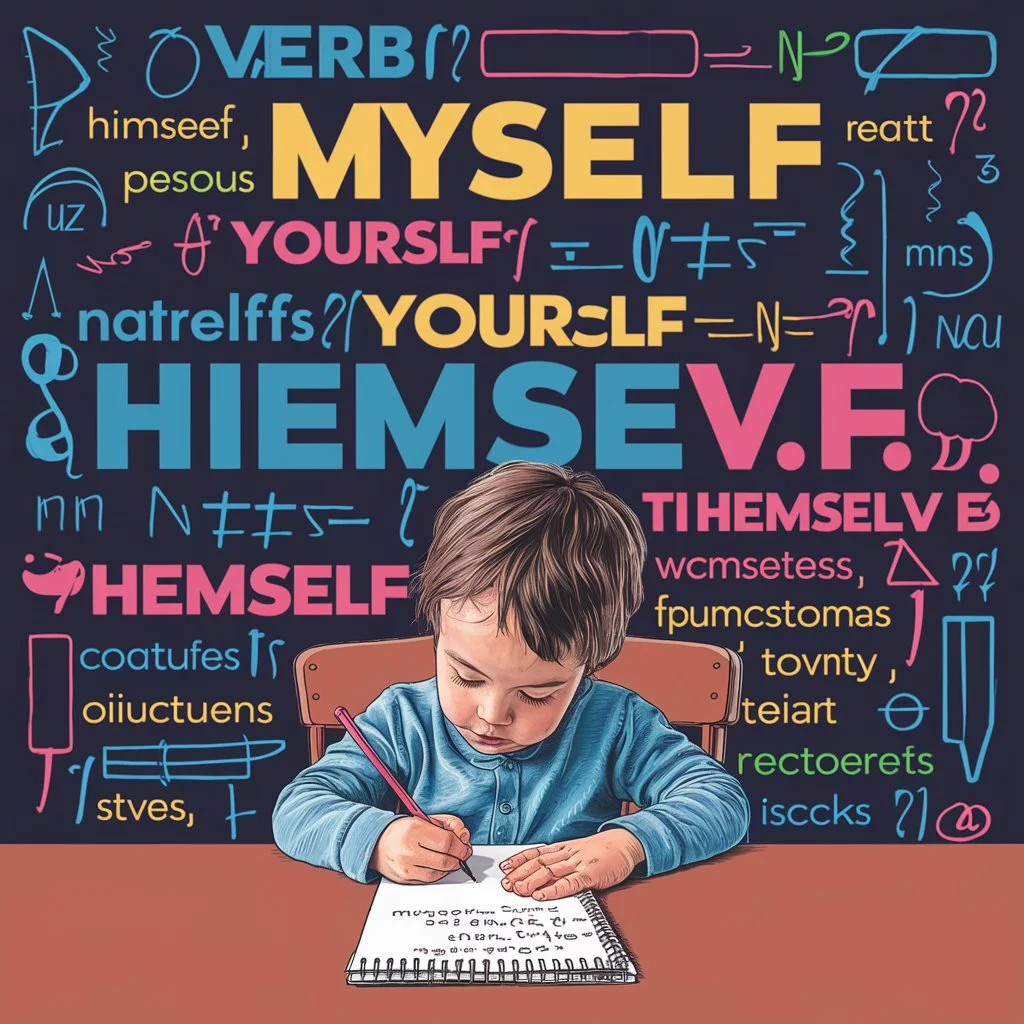Understanding reflexive pronouns is essential for mastering English grammar and making the writings more powerful and good. Reflexive pronouns are unique words, such as myself, yourself, himself, and themselves, play a crucial role in indicating actions that circle back to the subject performing them. When we say “I baked the cake myself” or “She treated herself to ice cream,” we emphasise that the action directly involves the person or group mentioned.
While reflexive pronouns typically reflect the action back to the doer, exceptions exist where they add emphasis or indicate surprise. Mastery of these pronouns not only enhances sentence clarity but also enriches expression in both written and spoken English.
What Are Reflexive Pronouns?
Reflexive Pronoun Definition:
Reflexive pronouns are a distinct category of pronouns in English that serve the dual function of referring to the subject of a sentence and indicating that the action of the verb returns to that same subject. These pronouns include myself, yourself, himself, herself, itself, ourselves, yourselves, and themselves. They are used when the subject and the object of a verb are the same entity.
For example, in the sentence “She dressed herself,” herself emphasizes that she performed the action of dressing on her own. Reflexive pronouns are crucial for clarity and precision in expressing self-directed actions in English grammar.
List of Reflexive Pronouns
- Myself
- Yourself
- Himself
- Herself
- Itself
- Ourselves
- Yourselves
- Themselves
Reflexive Pronouns Examples
Let’s see the reflexive pronouns examples and use in sentences:
- I baked the cake myself.
- Did you enjoy yourself at the party?
- He fixed the car himself.
- She did the painting herself.
- The cat groomed itself.
- We organized the event ourselves.
- You should be proud of yourselves.
- They made the costumes themselves.
- She dressed herself beautifully.
- He cooked dinner himself.
- We taught ourselves how to dance.
- They built the house themselves.
- I hurt myself while playing.
- Did you shave yourself this morning?
- The baby fed itself with the spoon.
- She reminded herself of the appointment.
- They decorated the room themselves.
- He cleaned the entire house himself.
- We painted the fence ourselves.
- You can trust yourself to make the right decision.
- The team congratulated themselves on their victory.
- I restrained myself from commenting.
- Did the cat clean itself after being outside?
- She found herself lost in the unfamiliar city.
- They amused themselves with jokes and games.
- He prepared himself for the upcoming exam.
- We booked the tickets ourselves online.
- You must challenge yourselves to achieve more.
- The children entertained themselves with toys.
- I asked myself why I hadn’t started earlier.
How to Use Reflexive Pronouns?
Using reflexive pronouns is simpler than you might think. They always reflect back to the subject of the sentence. Let’s look at some examples:
Sentence Correct Usage
I cut myself.The subject (I) cuts myself (the same person).
She treated herself to ice cream.The subject (She) treated herself (the same person).
They fixed the car themselves.The subject (They) fixed themselves (the same group).
I cut myself. Imagine you’re holding scissors, and you cut yourself – the action is coming back to you.
She treated herself to ice cream. Just like treating yourself to something special, the action of treating comes back to the same person – herself.
They fixed the car themselves. Imagine friends working on a car together. When they fix it themselves, the action circles back to them as a group.
Table of Action and Reflection
| Action | Reflexive Pronoun | Picture |
| I baked a cake | myself | You, baking a cake |
| He painted | himself | Him, with a paintbrush |
| We enjoyed | ourselves | Friends celebrating |
| She sang | herself | Her, singing |
Reflexive Pronoun Exceptions
While reflexive pronouns usually reflect the action back to the doer, there are times when they break their own rule and add a little twist. These exceptions might seem puzzling, but they’re here to make sentences more interesting and clear.
Unveiling the Exceptions:
For Emphasis:
Sometimes, reflexive pronouns jump in just to give extra oomph to the sentence. Imagine saying, “I myself will solve the puzzle.” Here, “myself” adds emphasis to show that you are taking charge.
- I myself will take care of the matter.
- She herself completed the entire project.
- He himself solved the difficult puzzle.
- We ourselves witnessed the event.
- They themselves decided to go on the trip.
- You yourself can make a difference.
- The cat cleaned itself perfectly.
- She baked the cake herself!
- He built the model airplane himself.
- They found the solution themselves.
No Clear Receiver:
When there’s no specific person or thing receiving the action, we might use reflexive pronouns. For example, “The cat cleaned itself.” Here, the cat did the action, and there’s no other recipient involved.
- The cat cleaned itself after playing outside.
- The baby fed itself with the bottle.
- The computer program updates itself automatically.
- The plant waters itself through a self-watering system.
- The robot adjusts itself to different surfaces.
- The car parks itself using advanced sensors.
- The door shuts itself quietly.
- The watch winds itself with movement.
- The smartphone screen adjusts brightness by itself.
- The machine cleans itself after each use.
Expressing Surprise:
Reflexive pronouns can pop up in sentences to show surprise or disbelief. Imagine saying, “She did it all by herself!” Here, “herself” adds a touch of wonder to the sentence.
- She did all the work by herself!
- He completed the entire marathon himself.
- They managed to solve the problem themselves.
- The child dressed herself for the first time.
- We built the entire structure ourselves.
- You cooked dinner yourself? That’s impressive!
- The cat caught the mouse itself.
- The team won the championship game themselves.
- He fixed the entire plumbing issue himself.
- She managed the project herself from start to finish.
Tips for Getting Reflexive Pronouns Right
Using reflexive pronouns might seem like a riddle, but fear not! With a bit of practice and these helpful tips, you’ll be weaving self-reflecting sentences like a pro in no time.
Match the Pronoun to the Subject:
Reflexive pronouns are like matching pairs – they need to align with the subject of the sentence. If the subject is singular, use “myself,” “yourself,” “himself,” “herself,” or “itself.” For plural subjects, go for “ourselves,” “yourselves,” or “themselves.”
Check the Action:
Ask yourself, “Is the action reflecting back to the doer?” If the answer is yes, a reflexive pronoun is likely needed. For example, “She dressed herself,” where the dressing action reflects back to her.
Watch for Emphasis:
Keep an eye out for situations where reflexive pronouns emphasize the action. If you’re saying, “I did it myself,” you’re emphasizing your role in the action.
Be Clear on Exceptions:
Remember the exceptions we talked about? Sometimes reflexive pronouns don’t follow the usual rules. So, when you see them in action, consider why they’re there – for emphasis, surprise, or when no clear recipient is involved.
Picture the Action:
Imagine the action happening right in front of you. If it’s an action that someone is doing to themselves, that’s your cue for a reflexive pronoun. It’s like watching a mini movie in your mind!
Practice with Play:
Turn learning into a game! Create sentences with reflexive pronouns in a fun and imaginative way. You can even challenge yourself to use them while describing your daily activities.
Take It Slow:
Learning any new skill takes time. Start with simple sentences and gradually incorporate more complex ones. Don’t rush – you’re on your way to becoming a reflexive pronoun master!
Proofread and Edit:
After writing, give your sentences a quick look to make sure the reflexive pronouns match the subject and action correctly. A little proofreading can make a big difference!
Be Patient with Yourself:
Mistakes happen, and that’s okay! Learning is all about making progress. If you slip up, take it as an opportunity to improve.
Reflexive Pronouns Exercises
Here are some exercises to help you practice reflexive pronouns, along with the answer keys.
Fill in the Blanks with the Correct Reflexive Pronoun
- They decorated the room ______________.
- He can fix the bike ______________.
- We need to believe in ______________.
- She told a story about ______________.
Answer Key:
- themselves
- himself
- ourselves
- herself
Identify the Reflexive Pronouns
Read the following sentences and identify the reflexive pronouns.
- She washed herself before going to the party.
- We made the sandwiches ourselves.
- He congratulated himself on the achievement.
- They enjoyed the movie all by themselves.
Answer Key:
- herself
- ourselves
- himself
- themselves
FAQs
How do you teach reflexive pronouns in a fun way?
Teach reflexive pronouns by using games and activities like role-playing and storytelling. Have students create sentences using themselves and act them out. Interactive exercises and visual aids can make learning more engaging.
When not to use reflexive pronouns?
Do not use reflexive pronouns when the action does not reflect back to the subject. For example, “He gave himself a gift” is correct, but “He gave a gift himself” is incorrect. Use regular pronouns instead when the action is directed at someone else.
What is the misuse of reflexive pronouns?
Misuse of reflexive pronouns occurs when they are used without a clear need. For example, “Please contact myself” is incorrect. The correct usage is “Please contact me.” Reflexive pronouns should only be used to reflect an action back to the subject.
What are the basic 4 reflexive pronouns?
The basic 4 reflexive pronouns are myself, yourself, himself, and herself. These pronouns are used when the subject and the object of a verb are the same person.
Is “myself” a reflexive pronoun?
Yes, “myself” is a reflexive pronoun. It is used when the subject “I” performs an action on the same person, as in “I taught myself to play guitar.”
What is a reflexive pronoun for dummies?
A reflexive pronoun is a word like myself or yourself that refers back to the subject of the sentence. It shows that the person doing the action is also the one receiving the action.
What is a reflexive pronoun in simple words?
A reflexive pronoun is used when the subject of the sentence does something to itself. For example, in “She cut herself,” “herself” shows that she did the action to herself.
Final tips
In conclusion, understanding reflexive pronouns is fundamental for clear and precise communication in English. These pronouns, such as myself, yourself, himself, and herself, play a crucial role in indicating actions that circle back to the subject performing them. Whether used for emphasis, surprise, or simply to clarify self-directed actions, mastering reflexive pronouns enhances both written and spoken language proficiency. By recognizing when and how to use them correctly, individuals can significantly improve the clarity and effectiveness of their communication.

It’s Elara Winters, your guide at “Grammer Grove.” I’ve dived into the intricacies of crafting the perfect English writing sections for your project, research paper, or thesis. With a wealth of experience in this field, I’m here to help you express gratitude and appreciation effectively. Join me on this journey, and let’s make your English writings shine!












